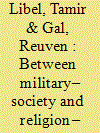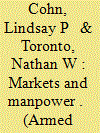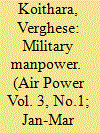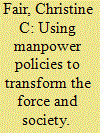|
|
|
Sort Order |
|
|
|
Items / Page
|
|
|
|
|
|
|
| Srl | Item |
| 1 |
ID:
129490


|
|
|
|
|
| Publication |
2014.
|
| Summary/Abstract |
Militaries commonly require recruits to pass a test that measures aptitude for military service. In this paper, we show that such tests may also act as a device for screening out low-motivation recruits, even if it is assumed that motivation is not measured by such tests and is not correlated with aptitude.
|
|
|
|
|
|
|
|
|
|
|
|
|
|
|
|
| 2 |
ID:
140561


|
|
|
|
|
| Summary/Abstract |
The growing religiosity in the Israel Defense Forces (IDF) in recent years is discussed by employing the broader lens of changes to the organization's overall manpower. First, the authors will indicate the dynamic and changing make-up of those serving in the IDF, in terms of both the socio-demographic characteristics of conscripted soldiers, and the motivation of individuals enlisting in the IDF. Second, it is demonstrated how a window has opened in the IDF, especially in combat units and command roles, for a growth in religiosity as a result of the gradual increase in the number of conscripts affiliated with the Zionist national-religious population.
|
|
|
|
|
|
|
|
|
|
|
|
|
|
|
|
| 3 |
ID:
069236


|
|
|
| 4 |
ID:
073023


|
|
|
|
|
| Publication |
Santa Monica, Rand Corporation, 2004.
|
| Description |
xi, 38p.
|
| Standard Number |
0833035878
|
|
|
|
|
|
|
|
|
|
|
|
Copies: C:1/I:0,R:0,Q:0
Circulation
| Accession# | Call# | Current Location | Status | Policy | Location |
| 051474 | 355.60973/ASC 051474 | Main | On Shelf | General | |
|
|
|
|
| 5 |
ID:
153623


|
|
|
|
|
| Summary/Abstract |
Economic studies of military manpower systems emphasize the advantages of voluntarism under all but the most total threats, but this explains neither the persistence of institutionalized conscription in many states nor the timing of shifts from such conscription systems to volunteer militaries. Traditional explanations focus on external threat levels, but this has also proven unsatisfying. We theorize that threat variables establish the state’s baseline need for manpower, but structural economic variables determine whether the necessary manpower can be more efficiently obtained by conscription or voluntarism. Using a new data set of 99 countries over 40 years, we find that states with British origins are less likely and those experiencing greater external threat are more likely to employ conscripts. Most importantly, states with more highly regulated labor markets are more likely to employ conscripts, which suggests that, controlling for a number of relevant factors, labor markets matter in military manpower decisions.
|
|
|
|
|
|
|
|
|
|
|
|
|
|
|
|
| 6 |
ID:
080647


|
|
|
| 7 |
ID:
177835


|
|
|
|
|
| Summary/Abstract |
The US Armed Forces officially desegregated in 1948. Over the following 70 years, the military has made great strides in promoting racial integration. We find evidence, however, that Black soldiers’ experience of military service still differs significantly from that of other racial and ethnic groups. Exploiting a database of administrative records for 100,000 Army personnel serving during the conflicts in Iraq and Afghanistan, we find that Blacks were less likely than other service members to have deployed, or to face intense combat if deployed, during the early phases of the campaigns.
|
|
|
|
|
|
|
|
|
|
|
|
|
|
|
|
| 8 |
ID:
105041


|
|
|
|
|
| Publication |
2011.
|
| Summary/Abstract |
Lotteries can be used to meet shortages in military-manpower-demanding situations before and during a large-scale war. By developing a new lottery mechanism that is fair in that everyone has the same success rate, the approach adopted in this paper is able to outperform the traditional lottery by generating extra rents in such a way that brothers or similar close family members can choose to maximize the chance that at least one person stays home, thereby reducing social cost. We use 2010 data for three war hot zones - namely, South Korea, Colombia and Taiwan - as examples.
|
|
|
|
|
|
|
|
|
|
|
|
|
|
|
|
| 9 |
ID:
086259


|
|
|
|
|
| Publication |
2009.
|
| Summary/Abstract |
It is widely believed that the unionization of military labor leads to reduced discipline and lower combat capability. Case studies of the performance of existing military unions, however, generally suggest that unionization has a benign impact on the performance of the armed forces. In this paper, we offer a theoretical economic analysis of the likely impact of military unionization on volunteer militaries. Our analysis suggests that military unionization will unambiguously lead to larger, but less disciplined, armed forces, leaving the overall impact of unionization on defense capability ambiguous. Military unionization, however, will clearly enhance social welfare.
|
|
|
|
|
|
|
|
|
|
|
|
|
|
|
|
| 10 |
ID:
130266


|
|
|
|
|
| Publication |
2014.
|
| Summary/Abstract |
Military manpower policies have an impact beyond the garrison. Policymakers have long held that military service can darn social fabrics that have been rent by ethnic, communal, class, and other cleavages, while scholars debate whether and how this occurs. Because military participation has implications for citizenship, marginalized groups have campaigned to be allowed to participate in the military, and leveraged their service to achieve greater enfranchisement. Military service affects the society as a whole in other ways as well: for example, leaders with military experience are less likely than others to prefer military force when other options are available. This paper examines the Pakistan Army, which, with its domination of the state, feared Islamist tendencies, and incessant belligerence toward India, seems to differ markedly from other militaries. But, using army recruitment and household survey data, it shows that even the Pakistan Army has used personnel policies to reshape its force, despite the numerous challenges of such a course. Whereas recent manpower studies dilate upon how socially marginalized groups employ military service to achieve greater access to citizenship, my analysis exposits how an army uses service in its ranks to cajole reluctant citizens into the national project of Pakistan and encumber them with the responsibilities and rights thereof. While this essay provides greater insights into the Pakistan Army specifically by focusing upon this ostensible anomaly, I hope to inform the larger literature on defense politics and the instrumentality of manpower policies.
|
|
|
|
|
|
|
|
|
|
|
|
|
|
|
|
| 11 |
ID:
171014


|
|
|
|
|
| Summary/Abstract |
This paper offers a first view on the potential economic outcomes for American women serving along-side men in combat roles. Specifically, this paper examines the impact of deployment and exposure to intense combat for women who served in the most high-risk occupations open to them in Iraq and Afghanistan on their subsequent use of GI bill benefits for higher education. It also compares these women to men who served in the same capacities and women who served in lower risk occupations. Women in general, and in these occupations in particular, were more likely than their male counterparts to use the GI bill. Following deployment, this paper presents robust evidence that women in all capacities, and men, were more likely to use their GI bill benefits. Moreover, exposure to intense combat, which was far more likely to impact these women than other women, detracted from their propensity to use the GI bill. This negative impact on pursuit of higher education was similar for both men and women. Taken together, this paper provides evidence that deployment may benefit the young men and women alike who serve in the U.S. military, and that both suffer together when faced with exposure to intense fighting.
|
|
|
|
|
|
|
|
|
|
|
|
|
|
|
|
|
|
|
|
|